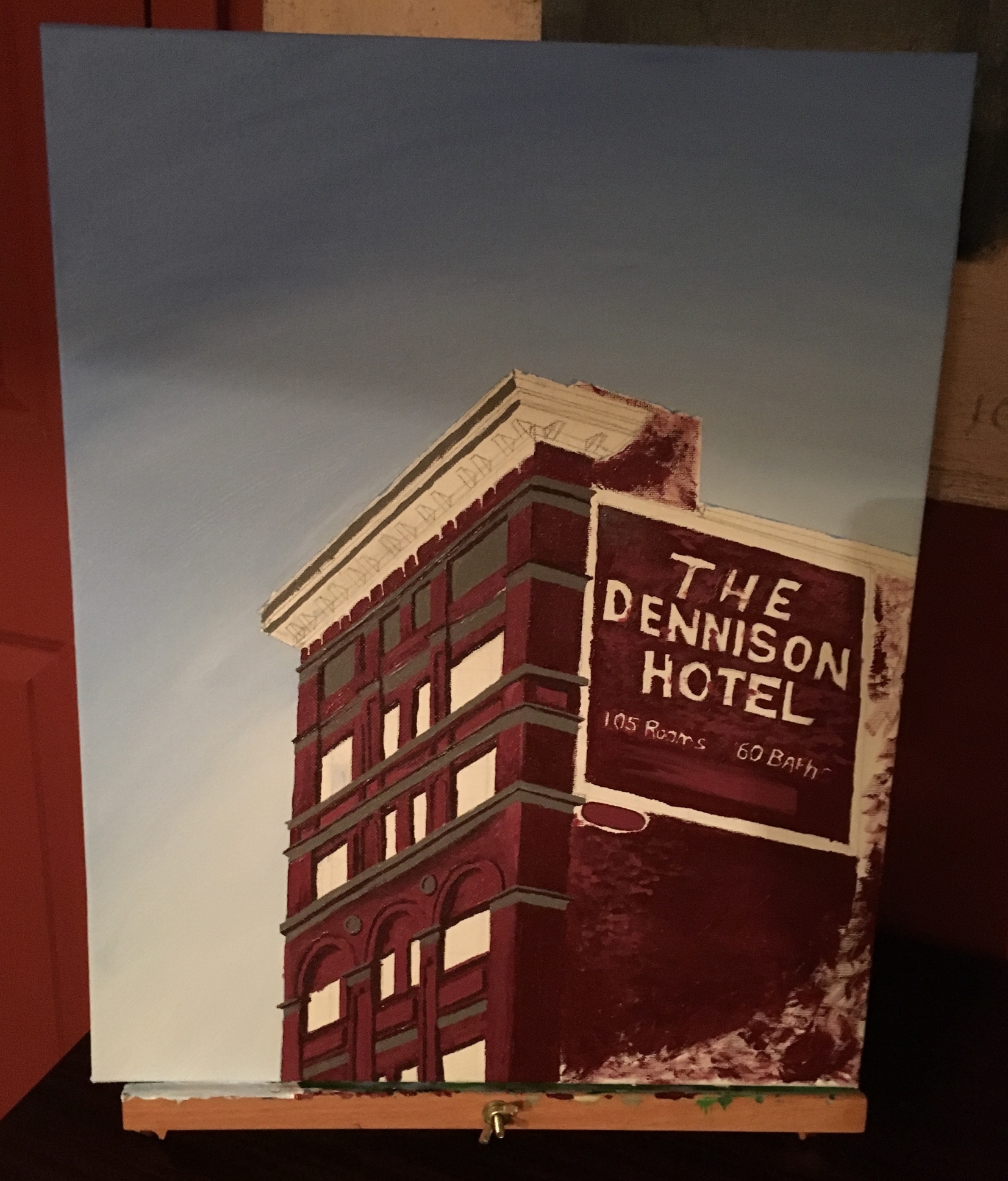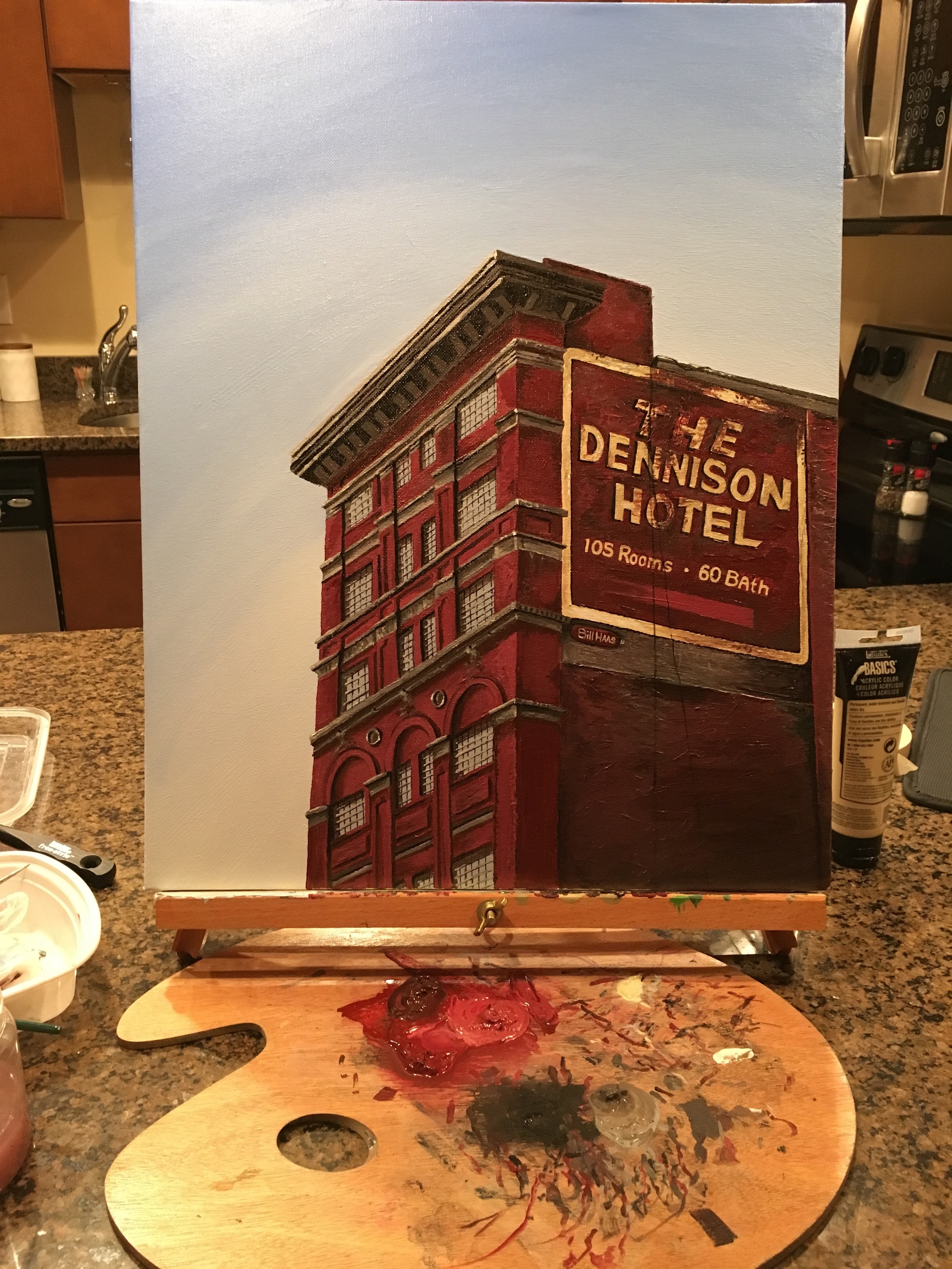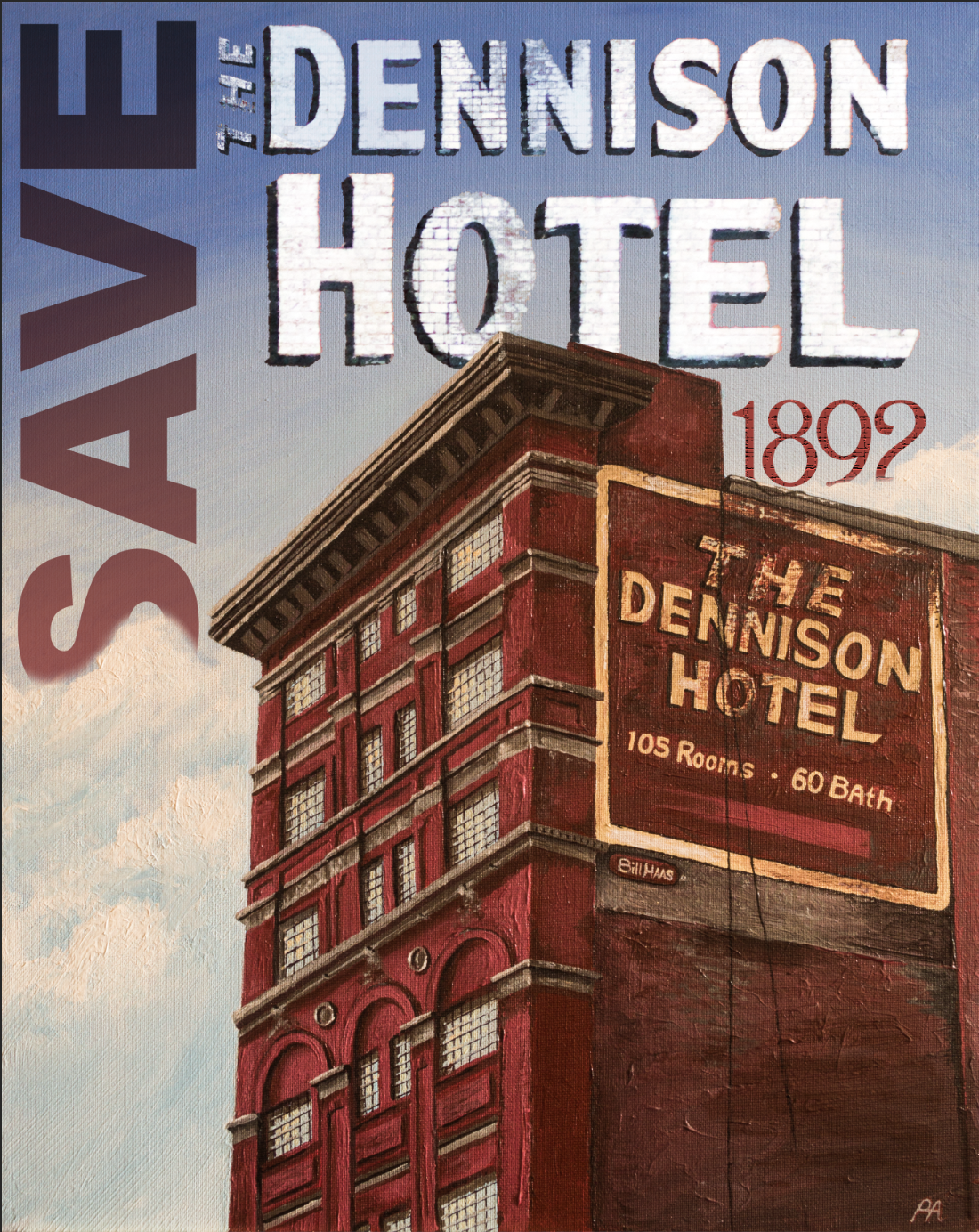“The Dennison Hotel”
Acrylic on canvas
16 in x 20 in
UPDATED STORY 4/25/2016: The CPC ended up adopting the painting as their primary source of imagery for the campaign to save the Dennison. I made posters at the Cincinnati Public Library and we spread them around town to local business including the Drinkery, MOTR, Ohio Bookstore, Indigo Hippo, Gray & Pape, Plaza Art Supplies, City Beat, Coffee Emporium and others. Shirts with a monochrome version of the painting were also made and sold at Park+Vine and Acme Lock for $10 a piece. I was extremely happy that it was able to be used as a way to bolster public awareness for the building's survival.
ORIGINAL STORY 3/13/2016: I painted a historic building to help save it from the wrecking ball. The story about why this painting exists, however, requires some explaining.
I don’t know everything about the Dennison Hotel. The biggest source of compiled information I can find online is from Digging Cincinnati History (a must read), and scouring Enquirer archives bears little information beyond that. Sanborns list a two story structure on its current site in 1887 and the current 8-story structure is there by 1904. Beyond these clues, the Dennison remains a bit of a ghost on Main Street. To summarize the DCH article (but I suggest you go read it), this 124 year old structure was built in 1892 for an ironworks company, and by the 1930s, the upper floors had become a hotel known as “the New Dennison Hotel”, eventually becoming a hotel in its entirety and low income housing after that.
It’s a beautiful historic building with modest features separating the windows and with prominent arches below layers of stone banding. Its height is disproportionate to it’s width which makes it seem taller than it actually is. The iconic, weathered fading ad boasting 105 rooms and 60 baths on its southern side distinguishes it from every other maroon-brick building in the city. Despite its unique beauty, however, the story of the inside of the building is pretty ugly. Combing newspaper archives yields a wide breadth of distressing activity that occurred within New Dennison; constant robberies, regular assaults, frequent fraudulent checks, suicides, a bomb threat, and even straight up murders. A serial killer claimed one of his victims there in 1991 and was later caught by authorities. Needless to say, its 105 rooms have witnessed the deepest, darkest depths of human depravity during its time.
Today it sits empty, its future uncertain, and it’s listed as one of the Cincinnati Preservation Collective’s 2015 Impact Buildings (buildings which are at risk and being monitored closely by the Collective in an effort to make a positive impact to improve their outcome). As a result of this demolition threat, I decided to paint the Dennison and create a poster in order to raise awareness of its existence. It's the only real thing I think I can do to help the cause. It couldn’t hurt it, after all. My friend Matt is part of the CPC, so with his guidance and encouragement, I put brush to canvas to try to assist the effort to save the Dennison.
Buildings are difficult to paint, however; I’ve never been a fan of trying to get perspectives right and lines straight with acrylics. Attempting endeavors such as these has always ended in non-starters and trashed canvases. I’ve never completed a single painting of a building because I always give up at some point, opting to discard the piece altogether rather than invest more time and energy into it. Because of these failures, I haven't attempted painting buildings until sitting down to work on the Dennison, and believe me, this canvas almost found the dumpster itself at several points in the process. Thankfully, determination kept it on the easel and the Dennison prevailed.
I started with a rough sketch of the proposed final product.
Then I took a photo of the building and placed a grid over it in photoshop. I blew it up to 16”x20”, the actual size of the canvas I would end up using, and drew the same grid on the blank canvas. Getting perspective right is tricky without a grid, so this helped me sketch out the building before actually starting painting. Honestly, this proved to be the most important part of the process because it locked down the dimensions early on and I could free hand it much easier which made adding color and detail easier. I know some painters don’t like drawing on the canvas prior to painting, but I find it to be an invaluable tool.
After the canvas sketch was complete, I started painting. Hours passed, many podcasts were listened to, and days of revisiting an unfinished product threatened to discourage me from proceeding. Mixing the same colors all over again is very difficult, after all. At one point, I was so disgusted by how it was turning out that I considered throwing it out entirely and telling Matt I couldn’t do it.
Instead, I took a picture and sent it to him and he promptly gave me positive feedback which encouraged me to just stick it out. Eventually, once the base colors were all down and open spots of canvas were covered, I started adding detail. Detailing is my favorite part of painting, a theme I realized mirrors the type of photography I prefer doing only after I started adding the detail. As detail was added, I started to appreciate the piece. Once the building was properly dirtied up, I was rather pleased with the end result.
I photographed it and loaded it back into Photoshop to add text to it. Below is the final version of the poster, barring any future text-based edits.
I’m hoping with this imagery now complete, and with Matt’s connection to organized preservationists, the Dennison Hotel can garner interest with the public and something can be done to stay the wrecking ball and save this piece of Cincinnati history. If you want this poster to display in your window (personal or business) free of charge, email me: philarmstrong2@gmail.com. The next time you’re on Main Street on the 700 block, take a moment and look up at the Dennison Hotel; it deserves a second chance in our wonderful city and the more people appreciate and talk about it, the better chance it has at sticking around for another hundred years.







